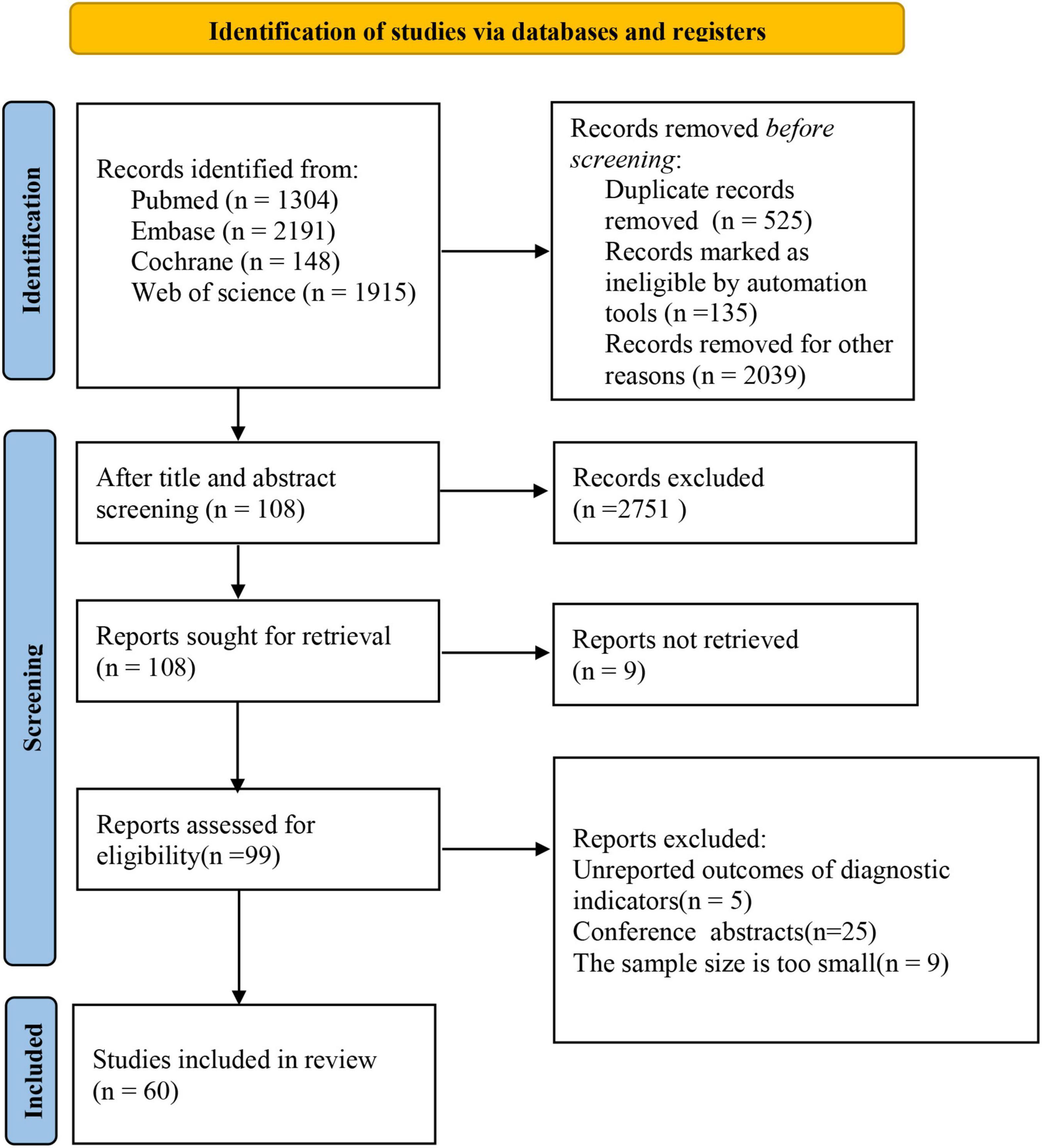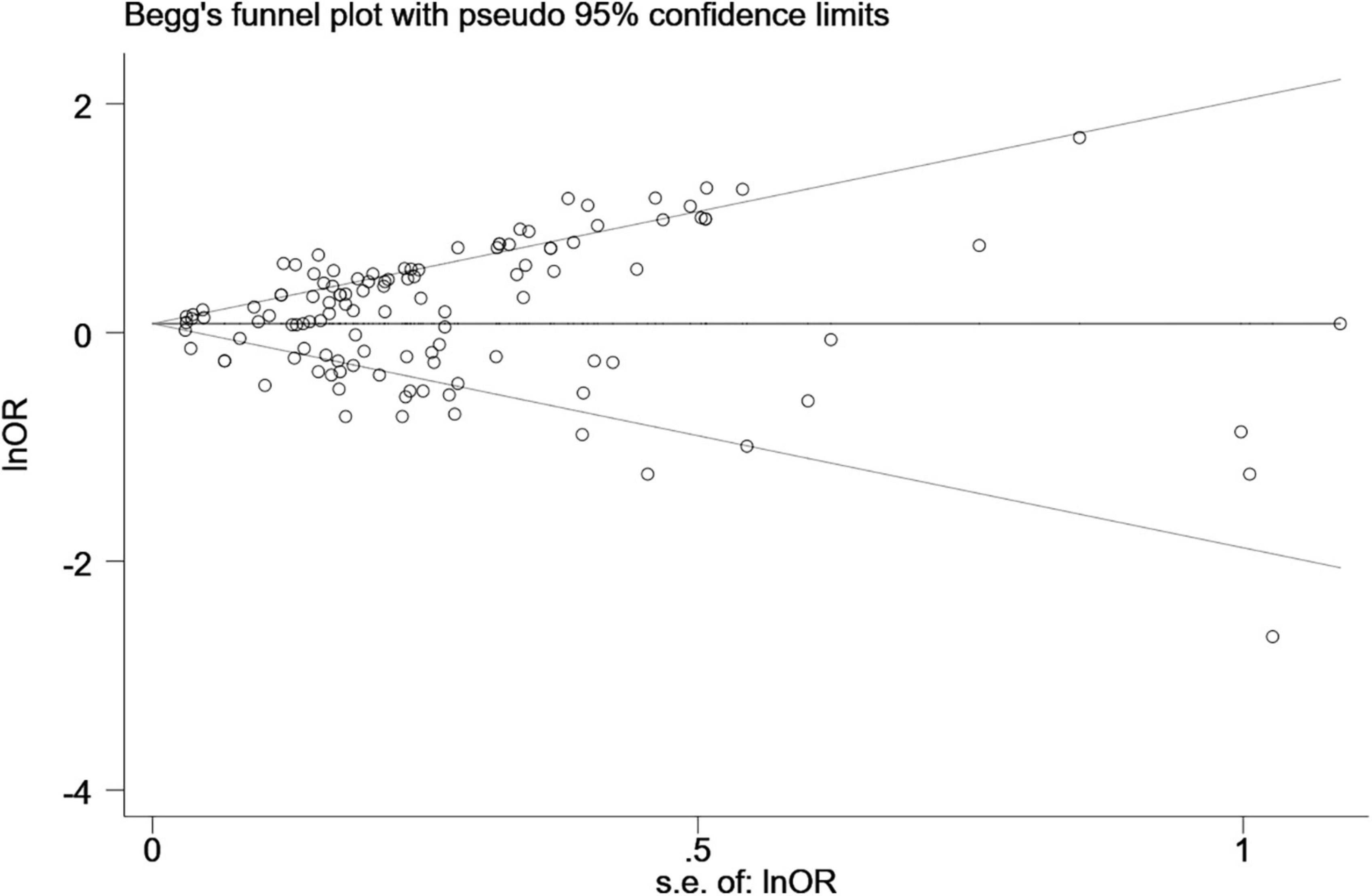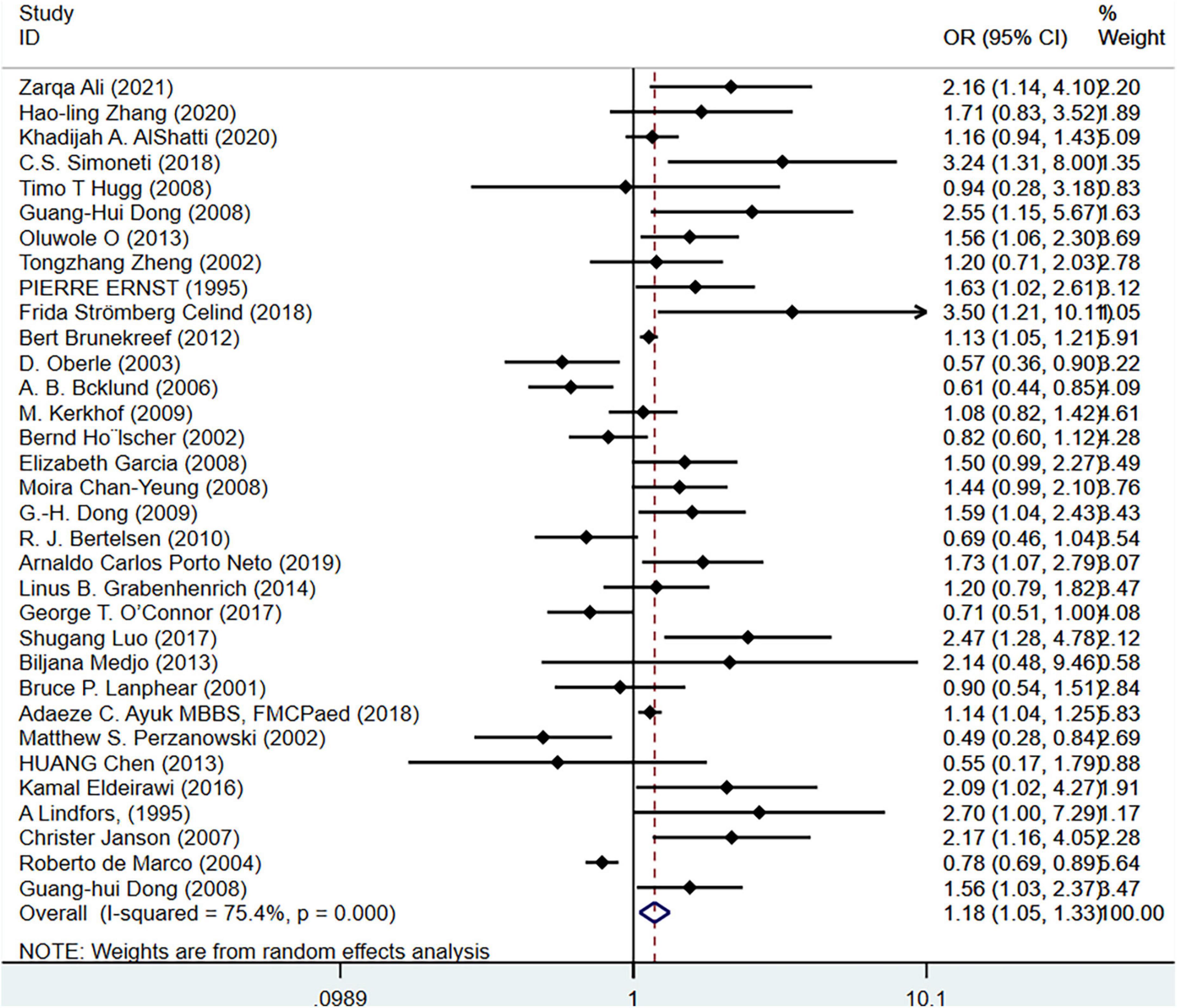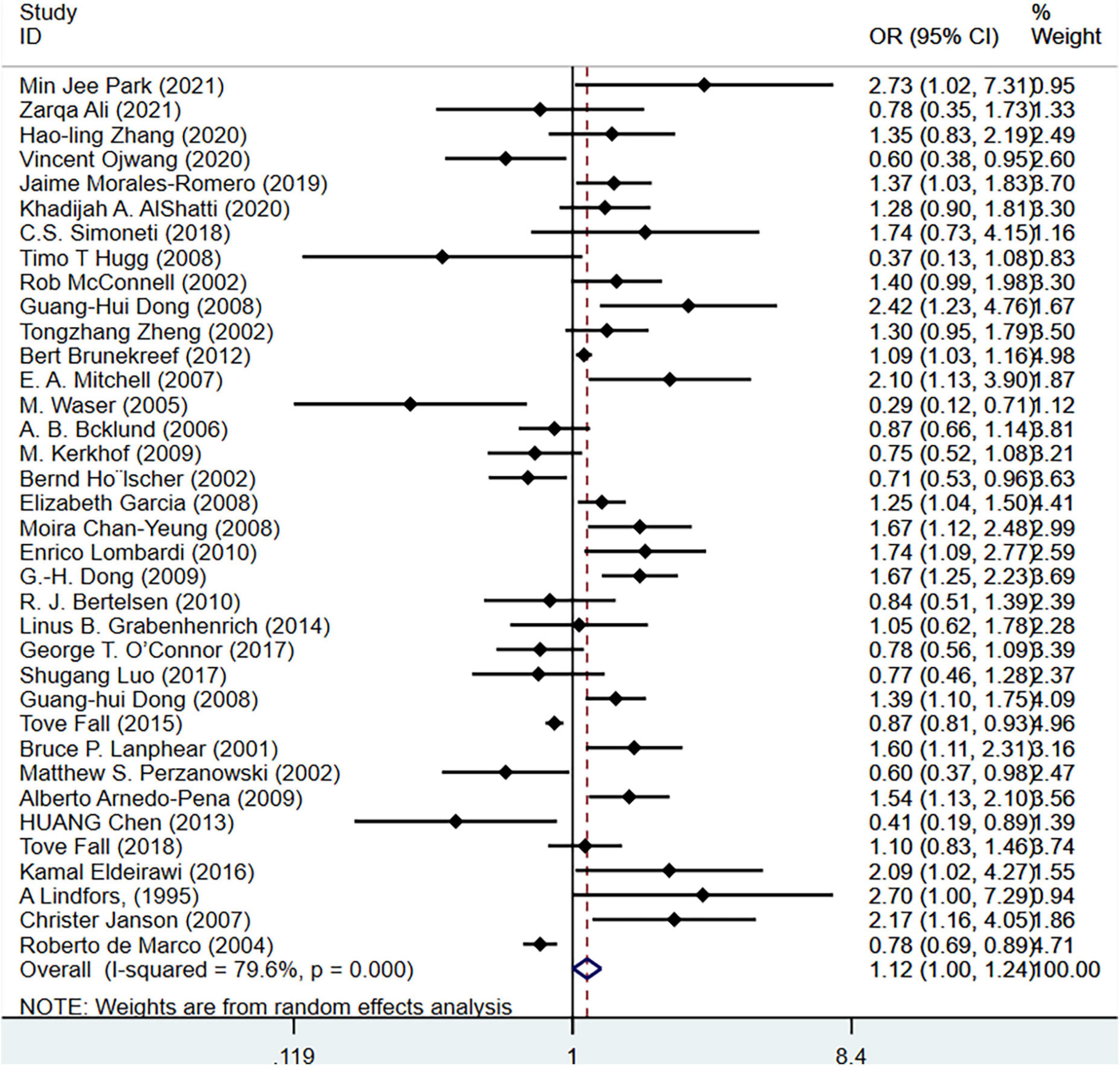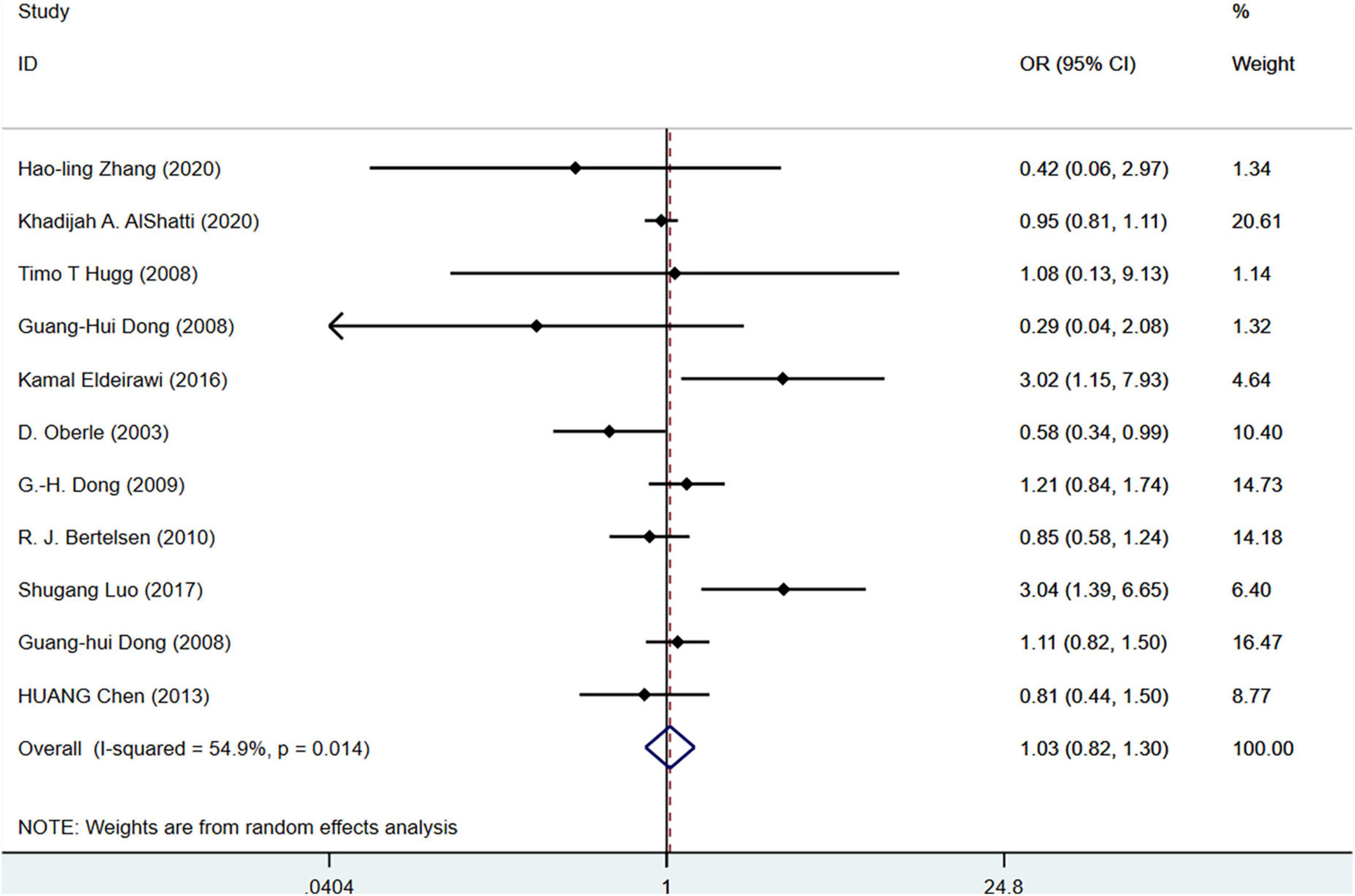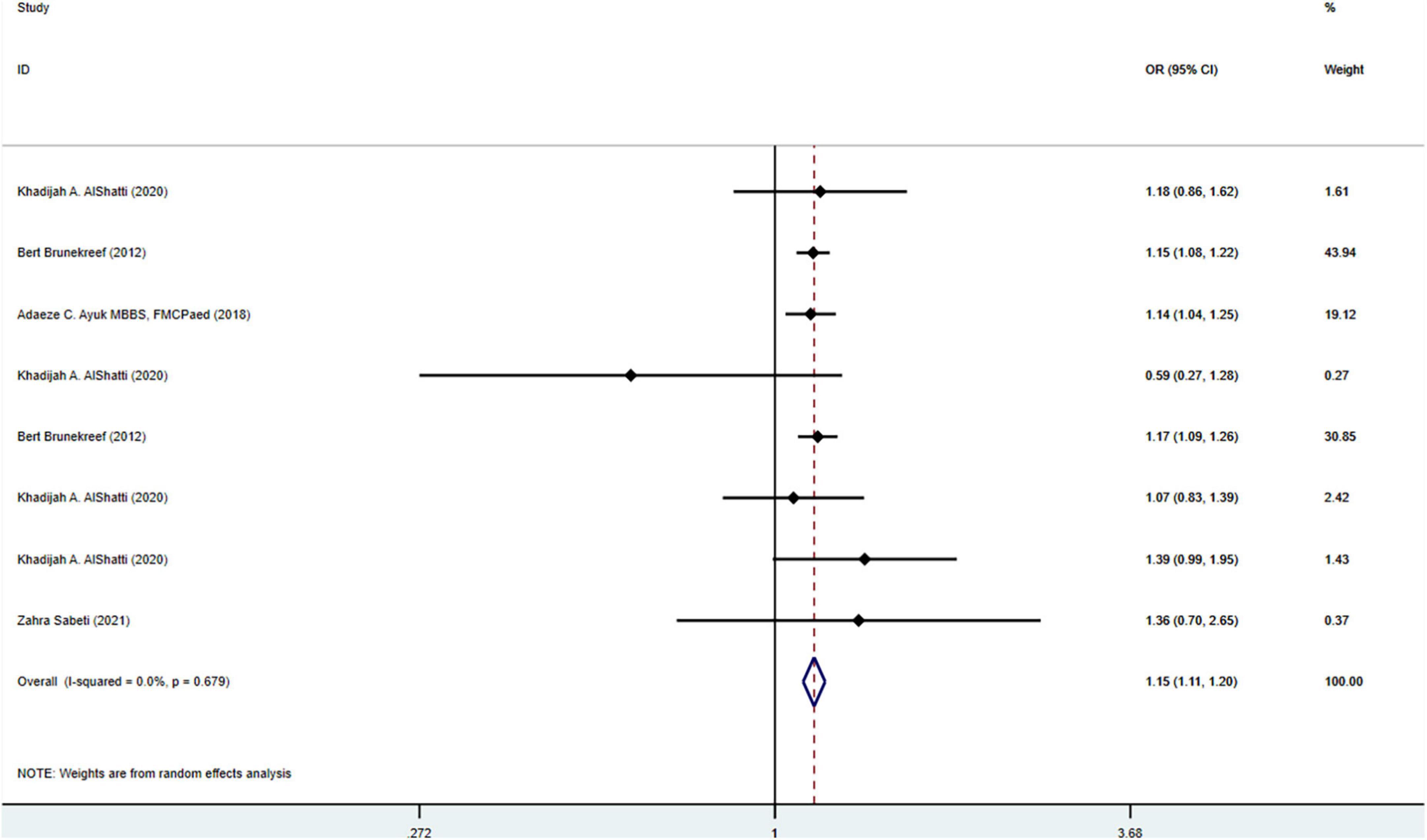- 1Department of Respiratory Medicine, Children’s Hospital of Soochow University, Suzhou, China
- 2Department of Pediatric, Jiaxing Maternal and Child Health Hospital, Jiaxing, China
- 3Department of Radiology, Jiaxing Maternal and Child Health Hospital, Jiaxing, China
Background and Objective: The relationship between pet ownership and childhood asthma remains controversial. In recent years, there have been increasing studies with large sample size. Therefore, we conducted this systematic review and meta-analysis to evaluate the relationship between pet ownership and childhood asthma.
Method: Relevant research was retrieved from PubMed, Cochrane, EMBASE, and Web of science. The retrieval was as of October 1, 2021. The Newcastle-Ottawa Scale (NOS) was used to assess the quality of the included studies. Stata 15.0 was used to conduct the meta-analysis.
Results: A total of 60 studies with large sample size published between 1995 and 2021 were included in this systematic review and meta-analysis, which included 18 cohort studies and 42 case-control studies covering 27 countries and 1,871,295 children. As shown by meta-analysis results, cat ownership (OR = 1.18, 95%CI: 1.05∼1.33) and dog ownership (OR = 1.12, 95%CI: 1.0 0∼1.24) have a significant bearing on the occurrence of childhood asthma. Pet ownership was also positively correlated with the occurrence of severe childhood asthma (OR = 1.15, 95%CI: 1.11∼1.20).
Conclusion: Pet ownership, especially cats and dogs, is associated with the occurrence of asthma in children.
Introduction
Asthma is one of the most common chronic respiratory diseases in the world nowadays. The overall prevalence around the world still remains high in 2019. According to global statistics, in 2019, there were more than 300 million people suffering from asthma. Among them, there are about 30 million patients with asthma in China, among which children account for 6 million. The prevention and control of childhood asthma is a critical challenge (1). In recent years, the prevalence of childhood asthma has been increasing year by year. The occurrence of childhood asthma will definitely increase the burden on families and society, which makes it a serious public health issue.
As is well known, there are various risk factors related with the occurrence of asthma, including vitamin D deficiency, gastrointestinal and respiratory microbiota, early exposure to antibiotics, smoking, air pollution, genetic risk factors, stress, ethnic differences, etc. (2). Previous studies have shown that pet grooming is related to the occurrence of allergic rhinitis. Yang et al. (3) proposed in their study that keeping away from hairy pets can reduce the sensitization of children at high risk for allergic diseases. Moreover, Zhang et al. (4) pointed out that pet ownership, serving as a key risk factor for the incidence of air pollution in the crowd, is bound up with the occurrence of allergic rhinitis. The relationship between pet ownership and childhood asthma still remains controversial. The study by Takkouche et al. (5) demonstrated that exposure to furry pets such as cats and dogs was associated with asthma. A systematic review in 2012 involving 11 cohort studies including data from 22,000 children did not support that pet ownership in infancy was associated with the risk of asthma at 6-10 years of age (6).
In recent years, there has been increasing case-control or cohort studies with large sample size on the relationship between pet ownership and childhood asthma. Therefore, we conducted this systematic review and meta-analysis to investigate the relationship between pet ownership and childhood asthma to provide guidance on the prevention of childhood asthma (7–9).
Method
Search strategy
A comprehensive and systematic search was conducted by using PubMed, Cochrane, EMBASE, and Web of science databases. The retrieval was as of October 1, 2021. In order to avoid the risk of omitting original research published during our project, we continued searching the databases mentioned above until we completed this research. The region was not restricted in the search, and the retrieval method was subject headings + free words. The subject heading used in PubMed was asthma [Mesh], Child [Mesh], pet [Mesh]. The retrieval strategy used in PubMed is shown in supplementary document 1.
Inclusion and exclusion criteria
The inclusion criteria were as follows: (1) The study type was case-control or cohort study. (2) The research subjects were children. (3) English literature. (4) The region and publication year were not limited. The exclusion criteria were as follows: (1) Non-English studies. (2) Studies including subjects older than children (>18 years old). (3) In order to avoid the influence brought by small sample size, we decided that studies with a sample size of less than 100 subjects should not be included in this systematic review. (4) Since the included original studies included case-control studies, there might be duplication of study subjects in multiple studies. Thus, if several studies contained the research subjects in the same region at the same time, we excluded studies with smaller sample size. (5) The confounding factors were not adjusted for outcome measures. (6) The original literature was not available.
Literature screening and information extraction
The retrieved studies were imported into Endnote X9. After excluding duplication, the titles and abstracts were screened and eligible studies were downloaded. A comprehensive screening was performed to determine the included studies. Before information extraction, a spreadsheet of information extraction was prepared for this research, including title, author, publication year, country, study type, time of selecting the research subjects, source area of selecting the research subjects, types of pets, age of disease development, statistical method, and type of asthma and confounders. Our outcome indicator was presented as the odds ratio (OR) value after confounders were controlled.
The aforementioned information extraction was carried out independently by two researchers (Ji and Yao) and cross-checked after completion. If there was any dissent, a third researcher (Zheng) was consulted to assist in determination.
Quality assessment
The types of the included original studies were cohort studies and case-control studies, and thus the Newcastle -Ottawa Scale (NOS) was used (10).
This scale evaluates the quality from three aspects: the selection of study groups, comparability between groups, and exposure/outcome. Among them, the highest scores in the selection of the study groups and the comparability between groups were 4 points and 2 points, respectively. If the exposure and outcomes were separately determined according to case-control study and cohort study, the highest score was 3 points. In the evaluation process, study with a score of >7 indicated high-quality research, and a score of 4-7 indicated moderate-quality research.
Quality assessment was conducted independently by 2 investigators (Ji and Yao) and cross-checked after completion. If there was any dissent, a third researcher (Zheng) was consulted to assist in determination.
Statistical analysis
The statistics used in our study were OR and the 95% confidence interval (OR (95%CI)). The heterogeneity index, I2, was used to measure the heterogeneity of each study. When I2 ≥50%, a random-effects model was used. When I2 <50%, a fixed-effects model was used. To determine the sources of heterogeneity, subgroup analyses according to pet types was conducted.
The funnel plot was used to visually illustrae publication bias. Begg and Egger’s tests were used to perform statistical tests. If there was publication bias, the cut-and-fill method was used to analyze the impact of publication bias on this meta-analysis. All statistical analyses were performed using Stata version 15.0 (StataCorp LLC, College Station, TX). P < 0.05 indicated that the difference was statistically significant.
Results
Results of literature screening
Based on our search strategy, a total of 5,558 studies were retrieved. After excluding duplicates and step-by-step screening, 60 studies were finally included in this meta-analysis. The screening process is shown in Figure 1.
Basic characteristics of the included studies
Among the 60 original studies, 18 were cohort studies (11–28) and 42 were case-control studies (7–9, 29–67), with 1,871,295 children included in this systematic review. The publication years of the included studies were from 1995 to 2021. The included studies covered 27 countries, with 26 from Europe, 15 from Asia, 12 from North America, 3 from Oceania, 3 from South America, and 1 from Africa. The detailed characteristics of the included studies were summarized in Table 1. In addition, the quality assessment results showed that most of the included studies were of high quality (Table 1).
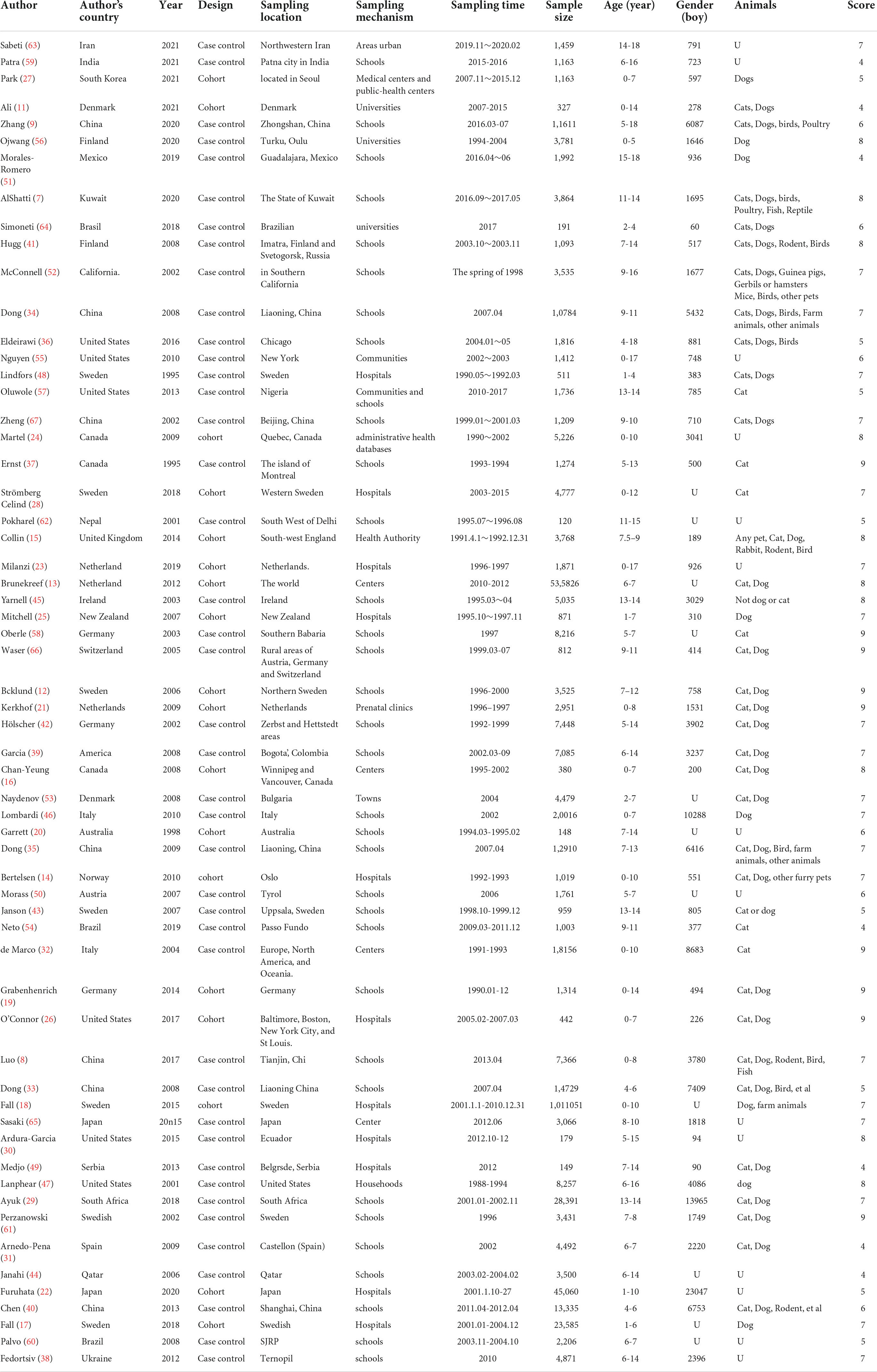
Table 1. Characteristics of the included studies and the assessment of quality of the studies according to the Newcastle-Ottawa Scale (NOS).
Meta-analysis results
The overall risk analysis on pet ownership and the onset of childhood asthma
A random-effects model (I2 = 79.1%) was used for the meta - analysis on 60 included studies. The results showed that the pet ownership was significantly correlated with the risk of childhood asthma onset (OR = 1.14, 95%CI: 1.08-1.21). Supporting information included the results of sensitivity analysis and publication bias assessment (Figure 2) (P < 0.05).
Subgroup analysis
First, we performed a subgroup analysis based on pet types. The results of the meta-analysis on 33 studies (N = 716,085) showed that cat ownership is significantly related to the occurrence of childhood asthma (OR = 1.18, 95%CI: 1.05-1.33, I2 = 75.4%, Figure 3). The results of the meta-analysis on 36 studies (N = 1,728,907) showed that dog ownership is significantly associated with the occurrence of childhood asthma (OR = 1.12, 95%CI: 1.00-1.24, I2 = 79. 6%, Figure 4). The results of the meta-analysis on 11 studies (N = 86,743) showed that other furry pet ownership was not associated with the occurrence of childhood asthma (OR = 1.03, 95%CI: 0.82-1.30, I2 = 54.9%, Figure 5). This study takes samples mainly from schools (OR = 1.223, 95%CI:1.012∼1.480,I2 = 77.4%) and hospitals (OR = 1.132, 95%CI:1.040∼1.233,I2 = 79.0%). Only few studies conducted subgroup analysis by gender, so it is insufficient to conduct a subgroup analysis by gender in our study. In addition, our study demonstrated that pet ownership was also significantly associated with severe childhood asthma (OR = 1.15, 95%CI: 1.11-1.20, I2 = 67.9%, Figure 6).
Discussion
This systematic review and meta-analysis on a large number of original studies with quantities of observational samples presented that pet ownership was significantly correlated with the risk of childhood asthma. There was a clear relationship between cat and dog ownership and the risk of childhood asthma. In addition, pet ownership was associated with the risk of severe childhood asthma. These results were obtained after pooling individual studies and adjusting the confounders.
Bronchial asthma is the most common chronic airway inflammatory disease in children. In recent years, the incidence of this disease has been increasing in our country, and asthma has become a public health issue attracting global attention. The etiology of asthma is complicated and closely related to genetic background, environmental factors, and immune function, including vitamin D deficiency, gastrointestinal and respiratory microbiota, early exposure to antibiotics, smoking, air pollution, genetic risk factors, stress, ethnic differences, etc. (2).
Cats and dogs have been companions for humans for thousands of years. Pet ownership provide various health benefits for humans, including ameliorating loneliness, attenuating psychological changes, promoting relationships, and acting as a protective factor against certain diseases, such as cardiovascular disease (68). In spite of these advantages, our study found that pet ownership, especially cats and dogs, could increase the risk of childhood asthma.
Currently, the mechanism underlying the positive correlation betweeen pet ownershipand the risk of childhood asthma remains unclear. Herre et al. (69) found that cats could secrete a type of protein, Feld 1, which was similar to Derp 2, the allergen in dust mites. Feld 1 can enhance signaling through innate receptors TLR4 and TLR2. The allergen from dogs, Canf 6, is a type of lipoprotein allergens with similar charateristics to Feld 1. Studies believed that Feld 1 and Canf 6 belonged to a group of allergen immunomodulatory proteins which significantly amplified LPS/TLR signaling in macrophage-like cells, thereby enhancing innate immune signaling and promoting airway hypersensitivity in patients with asthma. Other studies have found (70, 71) that pet is the main source of household endotoxins. Endotoxins are considered as pro-inflammatory agents which may be associated with promoting asthma (71, 72). A study by Akramiene et al. (73) and Douwes et al. (74) found that pet ownership increased the indoor concentration of fungi and dust. β-(1, 3)-d-glucan (beta-glucan), a glucose polymer existing in the fungal cell wall, was positively associated with the variability of peak expiratory flow (PEF) in children with asthma. Maheswaran et al.(75) discovered that exposure to β-glucan was a risk factor for atopic asthma. β-glucan can induce DC to stimulate Th17 cells, and the activation of Th17 cells may trigger inflammatory responses.
In recent years, there has been increasing case-control or cohort studies with large sample size on the relationship between pet ownership and childhood asthma. A study by Morales-Romeroden et al. (51) found that exposure to cats and dogs increased the risk of childhood asthma. Ayuk et al. (29) found that cat ownership is associated with severe asthma after investigating 258,267 children aged 13-14 in 10 African centers. Eldeirawi et al. (36) discovered that exposure to such pets as cats and dogs in utero is linked to an increased chance of asthma when studying Mexican American children aged 4-18. In the study of the relationship between bronchial hyperreactivity and the occurrence of asthma in children at the age of 7, Park et al. (27) found that dog ownership significantly increases the risk of non-atopic asthma. In 2020, in a survey on 11,611 students in Zhongshan City, China, Zhang et al. (9) found that pet ownership was associated with the prevalence of childhood asthma and the occurrence of asthma-related symptoms, especially in those who owned cats, poultry or slept with pets. A study in Tianjin demonstrated that (8), exposure to pets at an early age was positively correlated with asthma in Tianjin. A survey of 12 districts in 3 cities in Liaoning Province presented that pet ownership increased the risk of childhood asthma. In a cohort study by Ali et al. (11) found that pet ownership was positively related with the prevalence of asthma. In a population-based birth cohort study by Strömberg Celind et al. (28), it was also discovered that cat ownership increased the risk of uncontrolled asthma. The findings of these studies were consistent with our results on the association between pet ownership and childhood asthma, suggesting that our conclusion was reliable. Sensitivity analysis also proved the reliability of our results.
There were some advantages in our study. First, our research was based on a large number of studies with large sample size, which ensured the level of evidence. Second, the time of the studies included in our research was continuous, from 1995 to 2021. There will be literature reports in 2021. Third, the included studies involved all regions around the world, which weakened the influence brought by environment, race, and attitudes to a certain extent. Fourth, there was no publication bias in our research. Last, this research was the first proposing the association between pet ownership and severe asthma. Nonetheless, there were still some limitations. First, limited to the information in the original studies, we could not summarize the relationship between pet ownership and risk of childhood asthma according to different age groups. Second, limited to the information in the original studies, we were unable to obtain detailed information on the types of pets. Third, it was impossible to quantify and compare the risk of asthma in children with various pets other than cats and dogs.
Conclusion
We found that pet ownership, especially cats and dogs, was positively correlated with the occurrence of childhood asthma. Pet ownership was also positively correlated with the occurrence of severe childhood asthma. However, we did not deny human’s love for pet. When raising pets, it is better to choose those with less impact on the occurrence of childhood asthma. Furthermore, the contact of pets with infants should be avoided. At the same time, hygiene management of pets requires to be enhanced.
Data availability statement
The original contributions presented in this study are included in the article/supplementary material, further inquiries can be directed to the corresponding author/s.
Author contributions
XJ, YY, and CH contributed to the conception and design of the study. YY organized the database. PZ performed the statistical analysis. XJ wrote the first draft of the manuscript. YY, PZ, and CH wrote sections of the manuscript. All authors contributed to manuscript revision, read, and approved the submitted version.
Funding
The project was funded by support from Medical Health Science and Technology Project of Zhejiang Provincial Health Commission (2021KY1122).
Conflict of interest
The authors declare that the research was conducted in the absence of any commercial or financial relationships that could be construed as a potential conflict of interest.
Publisher’s note
All claims expressed in this article are solely those of the authors and do not necessarily represent those of their affiliated organizations, or those of the publisher, the editors and the reviewers. Any product that may be evaluated in this article, or claim that may be made by its manufacturer, is not guaranteed or endorsed by the publisher.
Acknowledgments
We thank the researchers and study participants for their contributions.
References
1. Huang K, Yang T, Xu J, Yang L, Zhao J, Zhang X, et al. Prevalence, risk factors, and management of asthma in China: a national cross-sectional study. Lancet. (2019) 394:407–18. doi: 10.1016/S0140-6736(19)31147-X
2. Stern J, Pier J, Litonjua AA. Asthma epidemiology and risk factors. Semin Immunopathol. (2020) 42:5–15.
3. Yang L, Fu J, Zhou Y. Research progress in atopic March. Front Immunol. (2020) 11:1907. doi: 10.3389/fimmu.2020.0190
4. Zhang Y, Zhang L. Increasing prevalence of allergic rhinitis in China. Allergy Asthma Immunol Res. (2019) 11:156–69.
5. Takkouche B, González-Barcala FJ, Etminan M, Fitzgerald M. Exposure to furry pets and the risk of asthma and allergic rhinitis: a meta-analysis. Allergy. (2008) 63:857–64.
6. Lødrup Carlsen KC, Roll S, Carlsen KH, Mowinckel P, Wijga AH, Brunekreef B, et al. Does pet ownership in infancy lead to asthma or allergy at school age? Pooled analysis of individual participant data from 11 European birth cohorts. PLoS One. (2012) 7:e43214. doi: 10.1371/journal.pone.0043214s
7. AlShatti KA, Ziyab AH. Pet-keeping in relation to asthma, rhinitis, and eczema symptoms among adolescents in kuwait: a cross-sectional study. Front Pediatr. (2020) 8:331. doi: 10.3389/fped.2020.00331
8. Luo S, Sun Y, Hou J, Kong X, Wang P, Zhang Q, et al. Pet keeping in childhood and asthma and allergy among children in Tianjin area, China. PLoS One. (2018) 13:e0197274. doi: 10.1371/journal.pone.0197274
9. Zhang HL, Wang BY, Luo Y, Li Y, Cai CS, Huang LL, et al. Association of pet-keeping in home with self-reported asthma and asthma-related symptoms in 11611 school children from China. J Asthma. (2021) 58:1555–64. doi: 10.1080/02770903.2020.1818772
10. Wells GA, Shea B, O’Connell J. The Newcastle-Ottawa Scale (NOS) for Assessing The Quality of Nonrandomised Studies in Meta-Analyses. Ottawa, ON: The Ottawa Hospital Research Institute (2014).
11. Ali Z, Jemec GBE, Ulrik CS. Associations between maternal and environmental exposures on atopic disease in the offspring of mothers with asthma. Immun Inflamm Dis. (2021) 9:862–70.
12. Bjerg-Bäcklund A, Perzanowski MS, Platts-Mills T, Sandström T, Lundbäck B, Rönmark E. Asthma during the primary school ages–prevalence, remission and the impact of allergic sensitization. Allergy. (2006) 61:549–55. doi: 10.1111/j.1398-9995.2006.01027.x
13. Brunekreef B, Von Mutius E, Wong G, Odhiambo J, García-Marcos L, Foliaki S. Exposure to cats and dogs, and symptoms of asthma, rhinoconjunctivitis, and eczema. Epidemiology. (2012) 23:742–50.
14. Bertelsen RJ, Carlsen KC, Granum B, Carlsen KH, Håland G, Devulapalli CS, et al. Do allergic families avoid keeping furry pets? Indoor Air. (2010) 20:187–95. doi: 10.1111/j.1600-0668.2009.00640.x
15. Collin SM, Granell R, Westgarth C, Murray J, Paul E, Sterne JA, et al. Pet ownership is associated with increased risk of non-atopic asthma and reduced risk of atopy in childhood: findings from a UK birth cohort. Clin Exp Allergy. (2015) 45:200–10.
16. Chan-Yeung M, Hegele RG, Dimich-Ward H, Ferguson A, Schulzer M, Chan H, et al. Early environmental determinants of asthma risk in a high-risk birth cohort. Pediatr Allergy Immunol. (2008) 19:482–9. doi: 10.1111/j.1399-3038.2007.00689.x
17. Fall T, Ekberg S, Lundholm C, Fang F, Almqvist C. Dog characteristics and future risk of asthma in children growing up with dogs. Sci Rep. (2018) 8:16899. doi: 10.1038/s41598-018-35245-2
18. Fall T, Lundholm C, Örtqvist AK, Fall K, Fang F, Hedhammar Å, et al. Early exposure to dogs and farm animals and the risk of childhood asthma. JAMA Pediatr. (2015) 169:e153219.
19. Grabenhenrich LB, Gough H, Reich A, Eckers N, Zepp F, Nitsche O, et al. Early-life determinants of asthma from birth to age 20 years: a German birth cohort study. J Allergy Clin Immunol. (2014) 133:979–88. doi: 10.1016/j.jaci.2013.11.035
20. Garrett MH, Abramson MJ, Hooper BM, Rayment PR, Strasser RP, Hooper MA. Indoor environmental risk factors for respiratory health in children. Indoor Air. (2010) 8:236–43.
21. Kerkhof M, Wijga AH, Brunekreef B, Smit HA, de Jongste JC, Aalberse RC, et al. Effects of pets on asthma development up to 8 years of age: the PIAMA study. Allergy. (2009) 64:1202–8. doi: 10.1111/j.1398-9995.2009.02016.x
22. Furuhata M, Otsuka Y, Kaneita Y, Nakagome S, Jike M, Itani O, et al. Factors associated with the development of childhood asthma in Japan: a nationwide longitudinal study. Matern Child Health J. (2020) 24:911–22.
23. Milanzi EB, Koppelman GH, Smit HA, Wijga AH, Vonk JM, Brunekreef B, et al. Role of timing of exposure to pets and dampness or mould on asthma and sensitization in adolescence. Clin Exp Allergy. (2019) 49:1352–61.
24. Martel MJ, Rey E, Malo JL, Perreault S, Beauchesne MF, Forget A, et al. Determinants of the incidence of childhood asthma: a two-stage case-control study. Am J Epidemiol. (2009) 169:195–205.
25. Mitchell EA, Robinson E, Black PN, Becroft DM, Clark PM, Pryor JE, et al. Risk factors for asthma at 3.5 and 7 years of age. Clin Exp Allergy. (2007) 37:1747–55.
26. O’Connor GT, Lynch SV, Bloomberg GR, Kattan M, Wood RA, Gergen PJ, et al. Early-life home environment and risk of asthma among inner-city children. J Allergy Clin Immunol. (2018) 141:1468–75.
27. Park MJ, Lee SY, Song KB, Lee SH, Choi KY, Lee KW, et al. Dog ownership in early life increased the risk of nonatopic asthma in children. Int Arch Allergy Immunol. (2021) 182:980–8.
28. Strömberg Celind F, Wennergren G, Vasileiadou S, Alm B, Åberg N, Goksör E. Higher parental education was associated with better asthma control. Acta Paediatr. (2019) 108:920–6.
29. Ayuk AC, Ramjith J, Zar HJ. Environmental risk factors for asthma in 13-14 year old African children. Pediatr Pulmonol. (2018) 53:1475–84.
30. Ardura-Garcia C, Vaca M, Oviedo G, Sandoval C, Workman L, Schuyler AJ, et al. Risk factors for acute asthma in tropical America: a case-control study in the City of Esmeraldas, Ecuador. Pediatr Allergy Immunol. (2015) 26:423–30. doi: 10.1111/pai.12401
31. Arnedo-Pena A, Puig-Barberà J, Bellido-Blasco JB, Pac-Sa MR, Campos-Cruañes JB, Artero-Sivera A, et al. Risk factors and prevalence of asthma in schoolchildren in Castellon (Spain): a cross-sectional study. Allergol Immunopathol (Madr). (2009) 37:135–42. doi: 10.1016/S0301-0546(09)71725-2
32. de Marco R, Pattaro C, Locatelli F, Svanes C. Influence of early life exposures on incidence and remission of asthma throughout life. J Allergy Clin Immunol. (2004) 113:845–52. doi: 10.1016/j.jaci.2004.01.780
33. Dong GH, Ding HL, Ma YN, Jin J, Cao Y, Zhao YD, et al. Housing characteristics, home environmental factors and respiratory health in 14,729 Chinese children. Rev Epidemiol Sante Publique. (2008) 56:97–107. doi: 10.1016/j.respe.2007.12.002
34. Dong GH, Ma YN, Ding HL, Jin J, Cao Y, Zhao YD, et al. Effects of housing characteristics and home environmental factors on respiratory symptoms of 10,784 elementary school children from northeast china. Respiration. (2008) 76:82–91. doi: 10.1159/000121370
35. Dong GH, Ma YN, Ding HL, Jin J, Cao Y, Zhao YD, et al. Pets keeping in home, parental atopy, asthma, and asthma-related symptoms in 12,910 elementary school children from northeast China. Indoor Air. (2009) 19:166–73. doi: 10.1111/j.1600-0668.2008.00576.x
36. Eldeirawi K, Kunzweiler C, Combs AM, Persky VW. In utero exposure to pets is associated with asthma and wheezing in Mexican American children. J Asthma. (2016) 53:374–81. doi: 10.3109/02770903.2015.1104693
37. Ernst P, Demissie K, Joseph L, Locher U, Becklake MR. Socioeconomic status and indicators of asthma in children. Am J Respir Crit Care Med. (1995) 152:570–5.
38. Fedortsiv O, Brozek GM, Luchyshyn N, Kubey I, Lawson JA, Rennie DC, et al. Prevalence of childhood asthma, rhinitis, and eczema in the Ternopil region of Ukraine–results of BUPAS study. Adv Med Sci. (2012) 57:282–9. doi: 10.2478/v10039-012-0034-6
39. Garcia E, Aristizabal G, Vasquez C, Rodriguez-Martinez CE, Sarmiento OL, Satizabal CL. Prevalence of and factors associated with current asthma symptoms in school children aged 6-7 and 13-14 yr old in Bogotá, Colombia. Pediatr Allergy Immunol. (2008) 19:307–14.
40. Chen HYH, Liu W, Zou Z, Sundell J. Correlation between asthma and allergy in preschool children and pet feeding in Shanghai. Chin Sci Bull. (2013) 58:8.
41. Hugg TT, Jaakkola MS, Ruotsalainen R, Pushkarev V, Jaakkola JJ. Exposure to animals and the risk of allergic asthma: a population-based cross-sectional study in Finnish and Russian children. Environ Health. (2008) 7:28. doi: 10.1186/1476-069X-7-28
42. Hölscher B, Frye C, Wichmann HE, Heinrich J. Exposure to pets and allergies in children. Pediatr Allergy Immunol. (2002) 13:334–41.
43. Janson C, Kalm-Stephens P, Foucard T, Alving K, Nordvall SL. Risk factors associated with allergic and non-allergic asthma in adolescents. Clin Respir J. (2007) 1:16–22.
44. Janahi IA, Bener A, Wahab AA. Pet ownership and associated respiratory diseases. Aerobiologia. (2006) 22:305–11.
45. Yarnell JW, Stevenson MR, MacMahon J, Shields M, McCrum EE, Patterson CC, et al. Smoking, atopy and certain furry pets are major determinants of respiratory symptoms in children: the international study of asthma and allergies in childhood study (Ireland). Clin Exp Allergy. (2003) 33:96–100. doi: 10.1046/j.1365-2222.2003.01572.x
46. Lombardi E, Simoni M, La Grutta S, Viegi G, Bisanti L, Chellini E, et al. Effects of pet exposure in the first year of life on respiratory and allergic symptoms in 7-yr-old children. The SIDRIA-2 study. Pediatr Allergy Immunol. (2010) 21:268–76. doi: 10.1111/j.1399-3038.2009.00910.x
47. Lanphear BP, Aligne CA, Auinger P, Weitzman M, Byrd RS. Residential exposures associated with asthma in US children. Pediatrics. (2001) 107:505–11.
48. Lindfors A, Wickman M, Hedlin G, Pershagen G, Rietz H, Nordvall SL. Indoor environmental risk factors in young asthmatics: a case-control study. Arch Dis Child. (1995) 73:408–12.
49. Medjo B, Atanaskovic-Markovic M, Nikolic D, Spasojevic-Dimitrijeva B, Ivanovski P, Djukic S. Association between pet-keeping and asthma in school children. Pediatr Int. (2013) 55:133–7.
50. Morass B, Kiechl-Kohlendorfer U, Horak E. The impact of early lifestyle factors on wheezing and asthma in Austrian preschool children. Acta Paediatr. (2008) 97:337–41. doi: 10.1111/j.1651-2227.2007.00633.x
51. Morales-Romero J, Bedolla-Pulido TI, Bedolla-Pulido TR, Pulido-Guillén NA, Bedolla-Barajas M, Padilla-Padilla R, et al. Asthma prevalence, but not allergic rhinitis nor atopic dermatitis, is associated to exposure to dogs in adolescents. Allergol Immunopathol (Madr). (2020) 48:34–41.
52. McConnell R, Berhane K, Gilliland F, Islam T, Gauderman WJ, London SJ, et al. Indoor risk factors for asthma in a prospective study of adolescents. Epidemiology. (2002) 13:288–95. doi: 10.1097/00001648-200205000-00009
53. Naydenov K, Popov T, Mustakov T, Melikov A, Bornehag CG, Sundell J. The association of pet keeping at home with symptoms in airways, nose and skin among Bulgarian children. Pediatr Allergy Immunol. (2008) 19:702–8. doi: 10.1111/j.1399-3038.2008.00721.x
54. Neto ACP, Solé D, Hirakata V, Schmid LS, Klock C, Barreto SSM. Risk factors for asthma in schoolchildren in Southern Brazil. Allergol Immunopathol (Madr). (2020) 48:237–43.
55. Nguyen T, Lurie M, Gomez M, Reddy A, Pandya K, Medvesky M. The National Asthma Survey–New York State: association of the home environment with current asthma status. Public Health Rep. (2010) 125:877–87. doi: 10.1177/003335491012500615
56. Ojwang V, Nwaru BI, Takkinen HM, Kaila M, Niemelä O, Haapala AM, et al. Early exposure to cats, dogs and farm animals and the risk of childhood asthma and allergy. Pediatr Allergy Immunol. (2020) 31:265–72.
57. Oluwole O, Arinola OG, Falade GA, Ige MO, Falusi GA, Aderemi T, et al. Allergy sensitization and asthma among 13-14 year old school children in Nigeria. Afr Health Sci. (2013) 13:144–53. doi: 10.4314/ahs.v13i1.20
58. Oberle D, von Mutius E, von Kries R. Childhood asthma and continuous exposure to cats since the first year of life with cats allowed in the child’s bedroom. Allergy. (2003) 58:1033–6. doi: 10.1034/j.1398-9995.2003.00285.x
59. Patra PK, Bhattarai D, Prasad A, Jain H, Ranjan S, Ranjan A. Prevalence and risk factors of asthma among school going children in urban area of North India. J Family Med Prim Care. (2021) 10:421–6. doi: 10.4103/jfmpc.jfmpc_1517_20
60. Palvo F, Toledo EC, Menin AM, Jorge PP, Godoy MF, Solé D. Risk factors of childhood asthma in Sao Jose do Rio Preto, Sao Paulo, Brazil. J Trop Pediatr. (2008) 54:253–7. doi: 10.1093/tropej/fmn007
61. Perzanowski MS, Rönmark E, Platts-Mills TA, Lundbäck B. Effect of cat and dog ownership on sensitization and development of asthma among preteenage children. Am J Respir Crit Care Med. (2002) 166:696–702. doi: 10.1164/rccm.2201035
62. Pokharel PK, Kabra SK, Kapoor SK, Pandey RM. Risk factors associated with bronchial asthma in school going children of rural Haryana. Indian J Pediatr. (2001) 68:103–6. doi: 10.1007/BF02722022
63. Sabeti Z, Ansarin K, Seyedrezazadeh E, Jafarabadi MA, Mohammadi B. A comparison of asthma prevalence in adolescents living in urban and semi-urban areas in northwestern Iran. Hum Ecol Risk Assess. (2021) 27: 2051–68.
64. Simoneti CS, Ferraz E, Menezes MB, Icuma TR, Vianna EO. Cat ownership is associated with increased asthma prevalence and dog ownership with decreased spirometry values. Braz J Med Biol Res. (2018) 51:e7558. doi: 10.1590/1414-431X20187558
65. Sasaki M, Yoshida K, Adachi Y, Furukawa M, Itazawa T, Odajima H, et al. Factors associated with asthma control in children: findings from a national Web-based survey. Pediatr Allergy Immunol. (2014) 25:804–9.
66. Waser M, von Mutius E, Riedler J, Nowak D, Maisch S, Carr D, et al. Exposure to pets, and the association with hay fever, asthma, and atopic sensitization in rural children. Allergy. (2005) 60:177–84. doi: 10.1111/j.1398-9995.2004.00645.x
67. Zheng T, Niu S, Lu B, Fan X, Sun F, Wang J, et al. Childhood asthma in Beijing, China: a population-based case-control study. Am J Epidemiol. (2002) 156:977–83. doi: 10.1093/aje/kwf127
68. Gómez GLF, Atehortua HCG, Orozco PSCP. La influencia de las mascotas en la vida humana. Rev Col Cienc Pec. (2007) 20:10.
69. Herre J, Grönlund H, Brooks H, Hopkins L, Waggoner L, Murton B, et al. Allergens as immunomodulatory proteins: the cat dander protein Fel d 1 enhances TLR activation by lipid ligands. J Immunol. (2013) 191:1529–35. doi: 10.4049/jimmunol.1300284
70. Park JH, Spiegelman DL, Gold DR, Burge HA, Milton DK. Predictors of airborne endotoxin in the home. Environ Health Perspect. (2001) 109:859–64.
71. Thorne PS, Cohn RD, Mav D, Arbes SJ, Zeldin DC. Predictors of endotoxin levels in U.S. housing. Environ Health Perspect. (2009) 117:763–71.
72. Tavernier GO, Fletcher GD, Francis HC, Oldham LA, Fletcher AM, Blacklock G, et al. Endotoxin exposure in asthmatic children and matched healthy controls: results of IPEADAM study. Indoor Air. (2005) 15:25–32. doi: 10.1111/j.1600-0668.2005.00354.x
73. Akramiene D, Kondrotas A, Didziapetriene J, Kevelaitis E. Effects of beta-glucans on the immune system. Medicina (Kaunas). (2007) 43:597–606.
74. Douwes J, Zuidhof A, Doekes G, van der Zee SC, Wouters I, Boezen MH, et al. (1–>3)-beta-D-glucan and endotoxin in house dust and peak flow variability in children. Am J Respir Crit Care Med. (2000) 162:1348–54. doi: 10.1164/ajrccm.162.4.9909118
Keywords: domestic, pet ownership, cat, dog, childhood, asthma, severe, meta-analysis
Citation: Ji X, Yao Y, Zheng P and Hao C (2022) The relationship of domestic pet ownership with the risk of childhood asthma: A systematic review and meta-analysis. Front. Pediatr. 10:953330. doi: 10.3389/fped.2022.953330
Received: 26 May 2022; Accepted: 04 July 2022;
Published: 22 July 2022.
Edited by:
Ziyaad Dangor, University of the Witwatersrand, South AfricaCopyright © 2022 Ji, Yao, Zheng and Hao. This is an open-access article distributed under the terms of the Creative Commons Attribution License (CC BY). The use, distribution or reproduction in other forums is permitted, provided the original author(s) and the copyright owner(s) are credited and that the original publication in this journal is cited, in accordance with accepted academic practice. No use, distribution or reproduction is permitted which does not comply with these terms.
*Correspondence: Chuangli Hao, aGNsX21kQDE2My5jb20=
 Xiaoyi Ji1,2
Xiaoyi Ji1,2 Chuangli Hao
Chuangli Hao